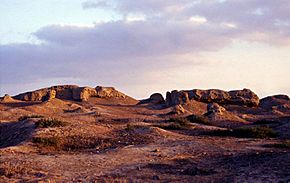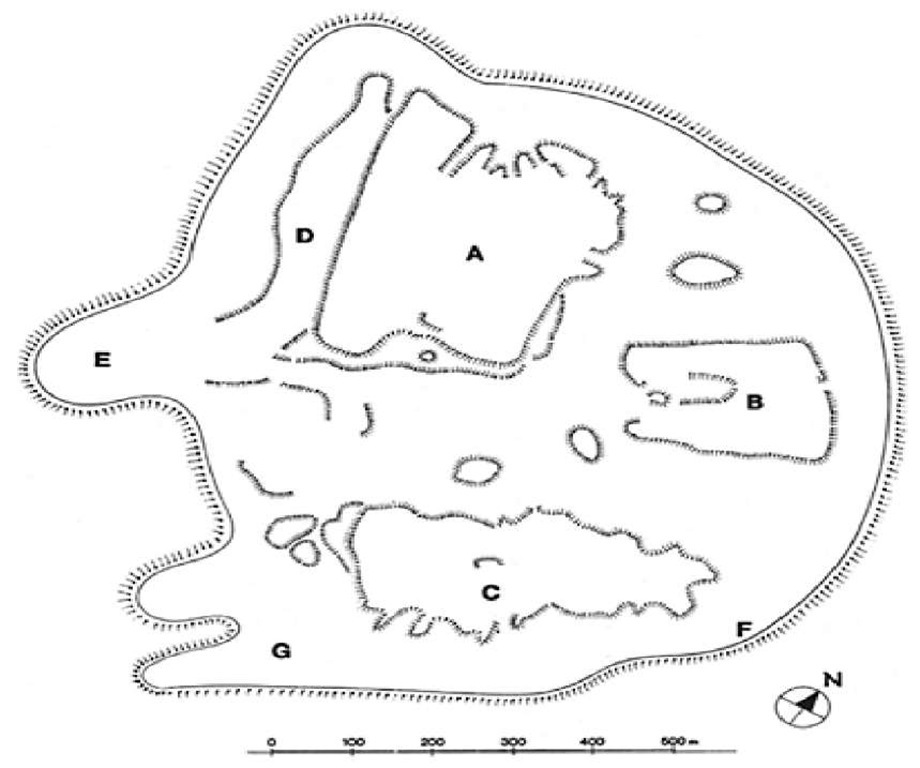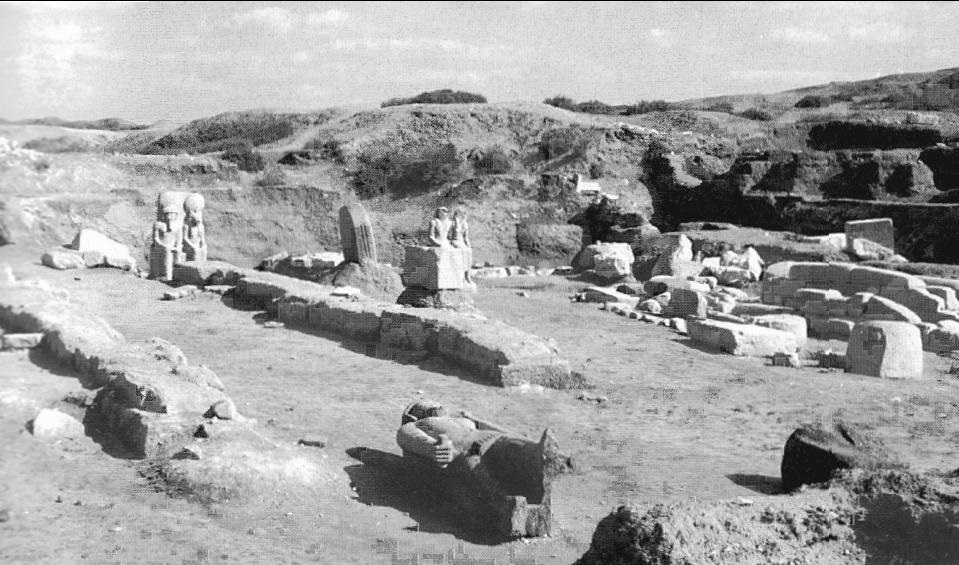Buto/Tell el-Fara'in
Predynastic to Late Period
By: Justin King
Introduction
The ancient, Lower Egyptian city of Buto, modernly known as Tell el-Fara'in, was the capital of the 6th Lower Egyptian Nome. Originally, two separate cities called Pe and Dep were located here, but they eventually merged into the large capital it was known to be. Buto was perceived as the counter-part to the Upper Egyptian capital of Hierakonpolis because of their different theologies and cultural beliefs, but played a pivotal role in the unification of Egypt. Today, this city is entirely buried under three separate mounds, with only Roman and Late Period reamains visible on the surface, so Tell el-Fara'in is normally translated to mean "mound of the pharaohs." These mounds have been greatly excavated, revealing highly significant pieces of archeological evidence. Tell el-Fara’in was first identified as Buto by Flinders Petrie in 1888, but not thoroughly excavated till the latter half of the 20th century when the Egypt Exploration Society started projects there in the 1960s. The significance of their findings revealed both Ptolemaic and Roman activity at Buto during the Late Period. It was not until the German Institute of Archaeology started excavating at this site in 1983, that Predynastic remains were found much deeper than previous excavations had dug. Today, German excavations are still being done at Tell el-Fara’in, and they hold the most recent finds and evidence.(Hartung GAI)
Location and Setting

The site of Tell el-Fara'in is regionally located northeast of the Nile Delta, and is about 60 miles east from the city of Alexandria. Surrounding the site, are both near and distant hills, patched with tall grass. The terrain itself is quite soft, making excavating quite easy. Given that Buto is located so close to the Nile River, it's clear that the annual floods would have molded the concentration of vegetation in and around the surrounding areas. Not only being one of the largest sites in the upper Delta, Buto is also known for being spatially consistent with the surrounding hills. Remains of Roman settlements are visible on the surface, and are essentially pocketed within the surrounding, elevated terrain. Overall, the fact that the Nile floods influenced the landscape, highlights the site of Buto as an area that showed changes in the terrain over long durations of time.(Hartung GAI)
Site Description

Tell el-Fara'in is roughly one square kilometer in size and is split into two general hills, one in the north and one in the south. The site also has a temple district that is bordered by clay brick walls that still stand tall today. The ancient remains that can still be seen on the surface, are mostly from the Roman times, but remains from the 26th dynasty are also visible. Any earlier evidence, such as predynastic or early Dynastic remains, are buried under several layers of sediment and some layers are beneath the groundwater level, making excavations increasingly difficult as depth increases. When excavations reach the groundwater level, special pumps are used to keep the area relatively dry, and archaeological methods are then applied.(Hartung GAI) The diagram to the left depicts how Buto is spatially laid out. The three large mounds are labeled A, B, and C, where mound A and C are large settlement mounds, and mound B is the temple precinct, which contains all the visible, ancient Roman remains on the surface. The two settlement mounds are about twenty meters above the surface and the majority of the site is archaeologically stratified into seven layers that correlate with a time period. The first two layers are actually the deepest and they contain the remains of a Predynastic Lower Egypt. Layers III, IV, and V correlate with the late Predynastic and Dynasty 0, while layer VI correlates with the early Old Kingdom. And the top layer, layer VII, contains the remains of the Late Period.(Bard, p182)
Archaeological Finds

Excavations at Buto have revealed a significant amount of evidence that has helped archaelogists paint a picture of what life was like, and how it changed over time in this ancient city. Flinders Petrie was the first to determine the site as Buto, but the Egyptian Exploration Society was the first archaeological establishment to thoroughly excavate it. Their excavations revealed Roman and Late Period remains that were mostly found in the temple precinct, but Late Period remains were also found in the early strata of the southern settlement mound. In the temple precinct, several building remains were found, along with pottery ovens, and a noticeable bathhouse in the northeast corner of the site as well It was not until the German Archaeological Institute began excavating here in the 1980s, that older and deeper strata could be reached. The GAI implemented a pumping system to remove the groundwater that had previously prevented excavations from reaching these deeper strata, in order to learn more about early life at Buto. By using this method, they were able to reveal the first evidence of Lower Egyptian Maadi Culture, and early Dynastic settlements as well. The German Archaeological Institue holds the most research on specific excavations and they outline what they found in each strata. Today, Ulrich Hartung leads the excavations at Buto and has revealed how life changed over time at this site.(Hartung Journal, p61)
Layers I and II were especially important because of the fact that they were being discovered for the first time, and also for the surprising amount of archaeological evidence they still contained, even though being below the groundwater level. The predynastic settlers lived on a 300 meter wide sand dune that was high enough to protect them from the annual floods, and from what we can determine, the early settlers of Buto lived in simple huts and depended on agriculture to survive. Given that they could stay safe from the annual floods, these early settlers of Buto used the Nile to their advantage and thrived agriculturally. An interesting find related to the predynastic times of Buto, were the traditional Chalcolite, clay vessels that possible immigrants from the southern Levant had made while they were living here. The ceramic evidence found here, revealed similarities to Upper Egyptian Naqada ceramics, and some ceramics weren't even distinguishable from the Upper Egyptian ceramic tradition, revealing evidence of unification. Ulrich Hartung and the GAI were also able to uncover more about the early Dynastic period at Buto from their excavations. They uncovered a palace-like structure with complex corridors, separated workshops, and areas of privacy as well. Archaeologists were able to determine that this structure was essentially a multi-purpose plant and had burned down in the middle of the second dynasty. This plant probably served agricultural purposes, such as organizing and producing, but evidence of stone vessel production is found at this early dynastic complex as well. This structure was portrayed by the evidence to be an early dynastic representation of power and authority, given the immense size of the plant and the extravagence of the ceramics found here as well. Remains of the Old Kingdom have been found only to a limited extent, because the Old Kingdom settlements run partially under a modern town and cemetary. The accessible Old Kingdom strata hold mostly ceramic evidence and very little evidence portraying everyday life. What archaeologists have been able to determine, however, is that Buto became abandoned for a long period of time at the end of the Old Kingdom. The reason why Buto was abandoned is not known for certain, but evidence suggests that the Nile temporarily stopped driving agriculture for the settlers, possibly due to drought, or even over flooding of the river as well. Any evidence from the New Kingdom was rare as a result. Statues and architecture were among the scarce New Kingdom evidence. Mostly found in the temple district, these New Kingdom remains could have been brought from other locations around Egypt, as was customary to honor the authority, but archaeologists have not been able to determine if a New Kingdom settlement ever thrived at Buto. The repopulation of Buto took place in the late 8th century, and the GAI was able to uncover elite tombs related to this time period. One elite tomb in particular, was untouched but badly preserved. This individual was buried in a granite tomb with extravegant bracelets around his arms. He could have been a prince or high authoritative figure, given that the decorative inscriptions revealed the name of Lupet II, a government seal.(Hartung GAI)

During the 26th Dynasty, Buto had significantly increased in size by this point, and the population was quite high as well. Archaeology of these later strata in the western settlement, revealed a major road, running north-south, with several houses lined up along either side of it. Four of these buildings were excavated by the German Archaeological Institute. Although only the foundations of these buildings were visible, some buildings were presumed to have multiple stories, given their large dimensions. This period of population expansion didn't last too long, because the archaeological evidence shows us that the population eventually condensed to the northern hill towards the end of the 6th century. The ruins of houses found here were apparently used as secondary burial grounds, revealing new information of Late Period burial traditions. The ceramic evidenc relating to this time period at Buto include locally produced vessels, and many other imported vessels from the Levant, Asia Minor, and Greece, showing the connection Buto had to the Mediterranean. The most recent strata, layer VII, contains most of the Late Period and Roman remains. Buto was heavily populated during this time and the city limits themselves were larger than earlier times. A wall stands at the southern border of Buto, surrounding what seems to be another temple area, and various housing structures were found in between this temple district and the settlements to the north. By using a magnometer, archaeologists were able to find several Roman furnaces that would have been used for the production of ceramics, and were able to reveal more about the bathhouse, previously excavated by the Egypt Exploration Society. With more effective archaeological methods, the German Archaeological Institute, and Ulrich Hartung, were able to excavate Buto more thoroughly than anyone before.(Hartung GAI)
Conclusion and Significance of Findings
Buto, once intensely excavated by the German Archaeological Institute, revealed several facts about the city that were previously unknown. For example, they were the first to excavate earlier strata that belonged to the Predynastic times. These earlier strata, being located below the water table, were able to be excavated because the GAI implemented a pumping system to their methods. Predynastic and early Dynastic settlements at Buto revealed how the population increased, given the increase in the size of the city itself, and other evidence pointed out how the ceramic traditions of Upper Egypt morphed their way into the ceramic traditions of Lower Egypt as well. Other early Dynastic evidence revealed an increase in authoritative power, such as the construction of temple districts. New Kingdom evidence was interesting because archaeologists could not determine if the New Kingdom artifacts at Buto were imported from other states around Egypt or not. These New Kingdom statues that were found in the temple district could have been from a New Kingdom settlement at Buto, but finding imported goods was not a rare occurence. The Late Period and Roman remains essentially proves to us how important Buto was. The amount of imported ceramics reveal how culturally diverse Buto was and how invovled it was with the Meditteranean. Buto simply gives us a good depiction of how ancient life changed over time.
Sources
Bard, Kathryn A, Encyclopedia of the Archaeology of Ancient Egypt. 180-182. Google Books. Web. accessed 8 Nov. 2016.
Hartung, Ulrich, Buto/Tell el-Fara'in, German Archaeological Institute. http://www.dainst.org/projekt/-/project-display Web. accessed 8 Nov. 2016.
Hartung, Ulrich, Buto(Modern Name:Tell el-Fara'in. Journal of Ancient Egyptian Interconnections, Vol. 7:4. Web. accessed 8 Nov. 2016.
Images
Image 1. Knight, Faris, Buto. Wikimedia. Retrieved from images.google.com.
Image 2. Breasted, James Henry. Whatwhenhow. Retrieved from images.google.com.
Image 3. Quercy, Sebastian, Bouto. Pinterest. Retrieved from pinterest.com.
Image 4. Kenawee, Adam, Temple Origin, Ancient Egyptian Temples. Blogspot. Retrieved from images.google.com

